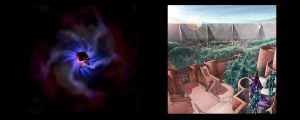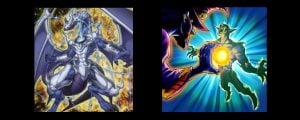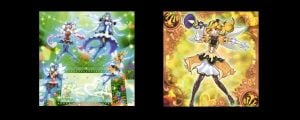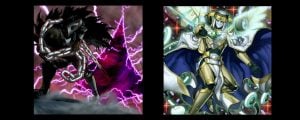Imperial Iron Wall chained to Allure of Darkness

Allure of Darkness allows you to draw two cards, but if you don't have a DARK monster in hand, you have to discard it in its entirety. Imperial Iron Wall prevents cards from being Banished. One may think that by chaining Iron Wall to Allure, they may force the opponent to discard their entire hand. However, it has the complete opposite effect!
The key to solving this ruling is a line within Allure of Darkness:
"...or, if you do not have any in your hand, send your entire hand to the Graveyard."
The antecedent of "any" being a DARK monster. Allure of Darkness does not have a cost. That is signified by the lack of semi-colons in the text. The condition for Allure of Darkness discarding your hand is not having a DARK monster in your hand. In this case, the player who activated Allure must reveal a DARK monster, not discard their hand.
This may seem simple, but I've had many players claim that Allure would discard your hand due to being unable to banish a DARK monster. Even commonly-known cards have intricacies to their card text.
Missing Timing

Cards "missing timing" has been eluding players for years. The big difference between cards that can miss timing are the words "if" and "when." If a card says "If..." followed by an activation timing, it cannot miss timing. This is because the activation timing is asking, for example "did this card go to the graveyard?"
It gets tricky when the card asks for a timing. For example, the text of Lightpulsar Dragon states:
"When this card is sent from the field to the Graveyard: You can target 1 Level 5 or higher DARK Dragon-Type monster in your Graveyard: Special Summon that target."
In this case, think of Lightpulsar Dragon asking for permission to use its effect at specifically the time it is sent from the field to the Graveyard. A classic example of this comes from a card that players used to exploit this timing: Soul Taker. By having an action happen after Lightpulsar Dragon is sent to the Graveyard, it misses the time at which it could activate its effect, like so:
Player 1 activates Soul Taker, targeting Lightpulsar Dragon.
- Soul Taker destroys Lightpulsar Dragon.
- Lightpulsar Dragon is sent to the GY. It asks, "Is there anything else going on? Can I activate?"
- The rest of Soul Taker's effect resolves, giving the opponent 1000 LP. Lightpulsar misses its timing.
Techs meant to exploit missing the timing are fairly new. It's much more common for a player's own cards to make them miss timing. These include tributing a monster with an "If..." effect for a tribute summon, as the card is sent to the GY at the same time the Tribute monster is being summoned.
What Starts a Chain?

Post Problem-Solving Card Text (PSCT), every effect that starts a chain has a colon (:) somewhere in its text. That means that the card can be chained to, and the effect or activation that is chained to it will become Chain Link 2.
By extension, this also means that cards that don't start a chain cannot be chained to. You could say that they cannot be reacted to. An example of such effects are Trickstar Light Stage and Trickstar Candina. These effects happen in response to Trickstar damage and Spell/Trap card activations respectively. They do not start a chain, they just happen when they specify.
Which Additional Normal Summons Stack?

There's a slight difference between effects that give you the ability to Normal Summon beyond your normal means. They are, for the most part, divided into two categories: raising the game's limit on how many legal Normal Summons you have, and the other give you an extra Normal Summon.
An example of the first category would be Chain Summoning. Rather than giving you the ability to Normal Summon again, Chain Summoning bends the rules of the game to do so. The second category would include cards such as Gem-Knight Seraphinite and Swap Frog. These give the player the ability to Normal Summon again.
These may seem like they have no distinction. However, it is important to identify which is which, as cards in the same category as each other do not stack. For example, you cannot use Double Summon and Chain Summoning to gain three Normal Summons. Essentially, they change the rules of the game to say "you can Normal Summon twice." Likewise, cards that give you additional Normal Summons do not stack.
Cards from different categories can stack, however! So if you play Double Summon and use Seraphanite, you can achieve three Normal Summons.
For a more comprehensive guide on these types of effects and the third, stranger category, refer to The Organization's article on the matter.
Difference Between Card Activations and Effects

The difference between a card activation and the activation of a card effect is that the former is when the card is placed on the field in order to initiate its activation. The latter is when an effect of a card is activated.
For example, an incredibly common question asked almost every week at my locals - c'mon guys! - is whether you can chain Ghost Ogre & Snow Rabbit in response to the activation of Union Hangar. It cannot! Ghost Ogre states that it can be activated under these conditions:
During either player's turn, when a monster on the field activates its effect, or when a Spell/Trap Card that is already face-up on the field activates its effect...
Union Hangar gets its search effect on its activation. That means that it was not already face-up on the field when its initial effect activates.
Similarly, Toadally Awesome's negation effect can be chained in response to the activation a Spell/Trap Card, or monster effect. That is to say, it can be chained to when a card is activated. This is different from an effect of cards like Breakthrough Skill, that activate their effect in the GY, but the card isn't being activated.




